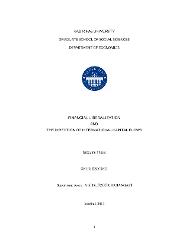| dc.contributor.advisor | Orhangazi, Özgür | en_US |
| dc.contributor.author | Ozdemir, Onur | |
| dc.date.accessioned | 2019-07-12T08:39:49Z | en_US |
| dc.date.available | 2019-07-12T08:39:49Z | en_US |
| dc.date.issued | 2013 | en_US |
| dc.identifier.uri | https://hdl.handle.net/20.500.12469/2366 | |
| dc.description.abstract | This study examines the direction of capital flows between developed and developing countries. Primarily almost all restrictions on capital mobility have reduced following the financial liberalization all over the world after 1980 period. One of the most important aim behind the liberalization policy is the providing of the resource allocation from capital-abundant developed countries to capital-scarce developing countries and thereby the stimulation of economic growth. in other words by doing so developed countries would become net capital exporter. However the analysis depending developing countries case and covering 2000-2011 period put different result. Actually capital is on net outflowing from developing countries to developed countries due to various reasons such as interest payments dividend payments past borrowings and copyright and patent fees. in other words contrary to the theoretical concept of the mainstream finance developing countries is placed as a net capital exporter in this period instead of developed countries. The main indicators which are using so as to reach this result are the current account and its two sub-items which are net income and royalty and licensing fees. Changings in both measures statistically prove that the developing countries are net capital exporter to developed countries. -- Abstract'tan. | en_US |
| dc.description.abstract | Bu çalışma gelişmiş ve gelişmekte olan ülkeler arasındaki sermaye akımlarının yönünü incelemektedir. Öncelikle, 1980 dönemi sonrasında finansal liberalleşme ile sermaye akımlarının önündeki neredeyse tüm engeller dünya çapında en aza indirilmiştir. Bu serbestleşme ve liberalleşme politikasının altında yatan en önemli amaçlardan biri, sermaye fazlasına sahip gelişmiş ülkelerden sermaye ihtiyacına gereksinimi olan gelişmekte olan ülkelere kaynak aktarımının sağlanması ve böylece ekonomik büyümenin canlandırılmasıdır. Bu durum çerçevesinde, gelişmiş ülkeler sermaye ihracatçısı rolünü üstlenmiş olacaklardır. Fakat gelişmekte olan ülkeler temelinde yapılan ve 2000-2011 arası dönemi kapsayan araştırma tam tersi bir sonuç ortaya koymaktadır. Sermeye, faiz ödemeleri, temettü giderleri, ülkelerin geçmiş borçları ve patent ve telif hakları ödemeleri gibi birçok neden dolayısıyla gelişmekte olan ülkelerden dışarı çıkmaktadır. Diğer bir anlamda, ana akım finans teorisinde planlananın aksine, gelişmiş ülkeler yerine gelişmekte olan ülkeler bu dönem içerisinde net sermaye ihracatçısı konumunda bulunmaktadır. Bu sonuca ulaşmakta kullanılan en temel göstergeleri ise ödemeler dengesi içerisindeki cari hesap ve bu hesabın iki alt kalemi olan net gelir hesabı ve telif ve lisans ücreti hesabı oluşturmaktadır. Tüm bu üç hesaptaki değişimler gelişmekte olan ülkelerin sermaye ihracatçısı rolünü istatistiksel olarak kanıtlamaktadır. | en_US |
| dc.language.iso | eng | en_US |
| dc.publisher | Kadir Has Üniversitesi | en_US |
| dc.rights | info:eu-repo/semantics/openAccess | en_US |
| dc.subject | Finansal Sektör | en_US |
| dc.subject | Finansal Liberalizasyon | en_US |
| dc.subject | Sermaye Akımları | en_US |
| dc.subject | Cari Hesap | en_US |
| dc.subject | Net Gelir | en_US |
| dc.subject | Telif ve Lisans Ücreti | en_US |
| dc.subject | Financial Sector | en_US |
| dc.subject | Financial Liberalization | en_US |
| dc.subject | Capital Flows | en_US |
| dc.subject | Current Account | en_US |
| dc.subject | Net Income | en_US |
| dc.subject | Royalty and Licensing Fees | en_US |
| dc.title | Financial Liberalization and direction of interenational capital flows | en_US |
| dc.type | masterThesis | en_US |
| dc.department | Enstitüler, Lisansüstü Eğitim Enstitüsü, Ekonomi Ana Bilim Dalı | en_US |
| dc.relation.publicationcategory | Tez | en_US |
| dc.identifier.yoktezid | 331941 | en_US |
















